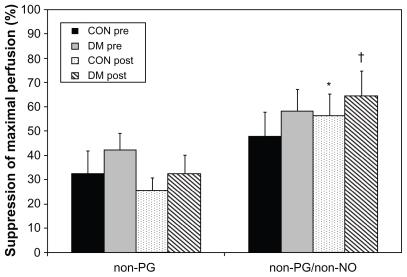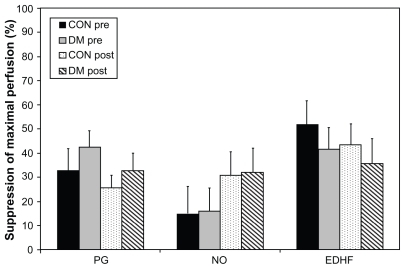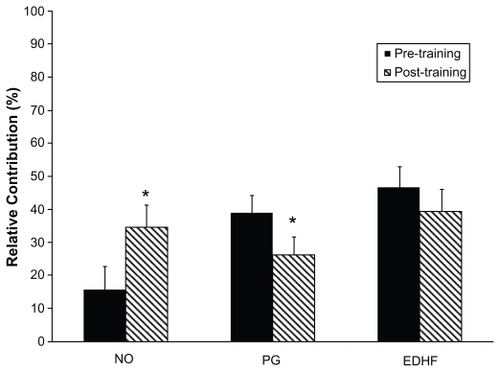Figures & data
Table 1 Subject characteristics
Figure 1 Suppression of maximally stimulated (44°C) dorsal skin perfusion by subject group pre- and post-training. “Non-PG” conditions include oral ingestion of aspirin and systemic suppression of PG synthesis by aspirin (left foot), while “non-PG/non-NO” conditions have inhibition of PG by aspirin and add local blockade of NO via microdialysis infusion of L-NAME, a NO synthase inhibitor (right foot). These results include oral aspirin ingestion in all subjects and have not yet been compared with normative data collected without aspirin. Subject groups are differentiated by both diabetes and training status.
Abbreviations: PG, prostaglandins; NO, nitric oxide; L-NAME, (N(G)-nitro-larginine methyl ester); CON, controls; DM, diabetes mellitus.

Figure 2 Suppression of maximally stimulated (44°C) dorsal skin perfusion attributable directly to each vasodilator when grouped by diabetes and training status. These data are examined as a percent of suppression attributable directly to each vasodilator individually, determined using normative data collected previously in a similar subject group without oral aspirin ingestion. Subject groups are differentiated by both diabetes (DM versus controls) and pre-and post-training status.
Abbreviations: PG, prostaglandins; NO, nitric oxide; EDHF, endothelial-derived hyperpolarizing factor; DM, diabetes mellitus; CON, controls; Pre, pretraining; Post, post-training.

Figure 3 Relative contribution of three vasodilatory pathways in response to maximal dorsal foot skin perfusion. Due to nonsignificant differences between groups in suppression of maximally stimulated skin perfusion both pre-and post-training, these data are presented with subject groups combined.
Abbreviations: CON, controls; DM, diabetes mellitus.
